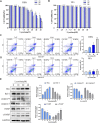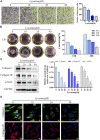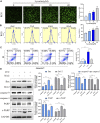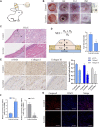Lycorine Inhibits Hypertrophic Scar Formation by Inducing ROS-Mediated Apoptosis
- PMID: 35685086
- PMCID: PMC9171077
- DOI: 10.3389/fbioe.2022.892015
Lycorine Inhibits Hypertrophic Scar Formation by Inducing ROS-Mediated Apoptosis
Abstract
Background: Hypertrophic scar (HS) is a fibrotic cutaneous disease with few effective therapies. Lycorine is a drug with pro-apoptotic ability and anti-fibrosis potential. This study aimed to test whether lycorine could trigger the apoptosis of hypertrophic scar fibroblasts (HSFs) to inhibit HS formation. Methods: The proapoptotic and anti-fibrosis effects of lycorine on the viability and apoptosis of human primary HSFs and their reactive oxygen species (ROS) production as well as a rabbit ear model of HS were determined by CCK-8, flow cytometry, Western blot, immunofluorescence, transwell migration, collagen gel contraction assays. Results: Lycorine treatment selectively decreased the viability of HSFs, and induced their apoptosis, but not normal fibroblasts (NFs). Lycorine treatment increased the relative levels of Bax and cleaved PARP expression, cytochrome C cytoplasm translocation, but decreased Bcl-2, caspase-3 and caspase-9 expression, the mitochondrial membrane potential (MMP) in HSFs. Lycorine inhibited the migration and contraction of HSFs, and reduced the expression of collagen I, collagen III and α-SMA. Mechanistically, lycorine treatment stimulated high levels of ROS production, leading to apoptosis of HSFs while treatment with NAC, a ROS inhibitor, significantly mitigated or abrogated the pro-apoptotic and antifibrotic activity of lycorine in HSFs. Moreover, lycorine treatment mitigated the severity of HS in rabbit ears by inducing fibroblast apoptosis. Conclusion: These results indicate that lycorine has a potent anti-fibrotic activity and is a potential drug for intervention of HS.
Keywords: apoptosis; fibrosis; hypertrophic scar; lycorine; reactive oxygen species.
Copyright © 2022 Dong, Lv, Zhao, Xu, Hu and Tang.
Conflict of interest statement
The authors declare that the research was conducted in the absence of any commercial or financial relationships that could be construed as a potential conflict of interest.
Figures







Similar articles
-
Dioscin improves hypertrophic scars by inducing apoptosis and ferroptosis of scar fibroblasts through mitochondrial oxidative stress damage.Eur J Pharmacol. 2025 Aug 15;1001:177759. doi: 10.1016/j.ejphar.2025.177759. Epub 2025 May 22. Eur J Pharmacol. 2025. PMID: 40412745
-
CYT997 induces apoptosis in hypertrophic scar fibroblasts and inhibits scar formation.Eur J Pharmacol. 2025 Sep 15;1003:177815. doi: 10.1016/j.ejphar.2025.177815. Epub 2025 Jun 6. Eur J Pharmacol. 2025. PMID: 40484336
-
Platycodin D inhibits the proliferation and migration of hypertrophic scar-derived fibroblasts and promotes apoptosis through a caspase-dependent pathway.Arch Dermatol Res. 2023 Jul;315(5):1257-1267. doi: 10.1007/s00403-022-02513-1. Epub 2022 Dec 16. Arch Dermatol Res. 2023. PMID: 36526799 Free PMC article.
-
Fraxinellone-mediated targeting of cathepsin B leakage from lysosomes induces ferroptosis in fibroblasts to inhibit hypertrophic scar formation.Biol Direct. 2025 Feb 4;20(1):17. doi: 10.1186/s13062-025-00610-5. Biol Direct. 2025. PMID: 39905520 Free PMC article.
-
ABT-263 Reduces Hypertrophic Scars by Targeting Apoptosis of Myofibroblasts.Front Pharmacol. 2021 Jan 14;11:615505. doi: 10.3389/fphar.2020.615505. eCollection 2020. Front Pharmacol. 2021. PMID: 33519480 Free PMC article.
Cited by
-
The Molecular Mechanisms Involved in the Hypertrophic Scars Post-Burn Injury.Yale J Biol Med. 2023 Dec 29;96(4):549-563. doi: 10.59249/RHUF5686. eCollection 2023 Dec. Yale J Biol Med. 2023. PMID: 38161582 Free PMC article. Review.
-
Gallic Acid Nanocrystal Hydrogel: A Novel Strategy for Promoting Wound Healing and Inhibiting Scar Formation.Int J Nanomedicine. 2025 Apr 11;20:4607-4626. doi: 10.2147/IJN.S514961. eCollection 2025. Int J Nanomedicine. 2025. PMID: 40236519 Free PMC article.
-
NIR-II light based combinatorial management of hypertrophic scar by inducing autophagy in fibroblasts.J Nanobiotechnology. 2024 Oct 15;22(1):625. doi: 10.1186/s12951-024-02876-9. J Nanobiotechnology. 2024. PMID: 39407227 Free PMC article.
-
S-Nitrosylation-mediated coupling of DJ-1 with PTEN induces PI3K/AKT/mTOR pathway-dependent keloid formation.Burns Trauma. 2023 Dec 18;11:tkad024. doi: 10.1093/burnst/tkad024. eCollection 2023. Burns Trauma. 2023. PMID: 38116467 Free PMC article.
References
LinkOut - more resources
Full Text Sources
Research Materials

